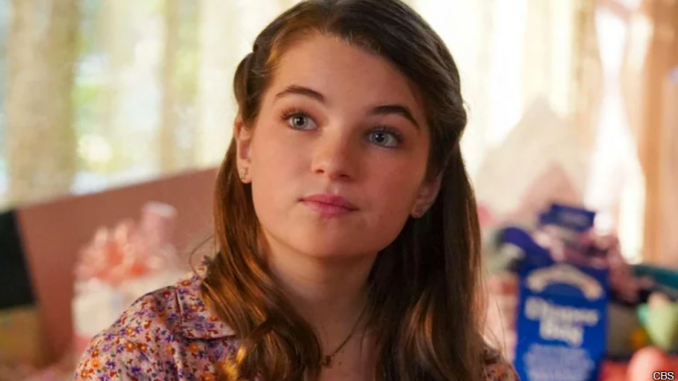
Raegan Revord played Missy Cooper—Sheldon’s sharp-witted and rebellious sister—for seven seasons on Young Sheldon. Yet, despite her fiery personality, one thing about Missy remained oddly static: her hair. Sure, there were rare exceptions—she occasionally wore a ponytail, and in one episode, she even dyed her hair blonde. But for the most part, her hairstyle never changed, which felt a bit inconsistent for a character known for pushing boundaries.
Behind the scenes, Revord repeatedly asked for a haircut, only to be denied for four years straight. It wasn’t until Season 6—after she experienced a traumatic real-life car crash—that she was finally allowed to change her look. Following much debate, the showrunners granted her request.
In a 2023 interview with Entertainment Tonight, Revord recalled the moment:
“They called me over and said, ‘Hey, we have some news for you.’ Then my hair person walked in, and I was like, ‘No, no, no, no, no. This is not happening!’ But they told me, ‘You get to cut your hair.’ Now I have short hair, and I love it so much. I got Van Leeuwen [ice cream] and a haircut—what more can you ask for?”
Missy’s shorter hairstyle made its debut in Young Sheldon Season 6, Episode 18 (Little Green Men and a Fella’s Marriage Proposal). However, even then, the change was relatively subtle—nowhere near as drastic as Penny’s (Kaley Cuoco) pixie cut in The Big Bang Theory Season 8, which caused quite a stir among fans.
The Big Bang Theory Rule That Almost Never Breaks
The reason Missy’s hair stayed the same for so long? Big Bang Theory creator Chuck Lorre has a strict rule against major cast members making drastic hairstyle changes. Penny’s pixie cut was a rare exception, and it reportedly caused some behind-the-scenes tension.
In The Big Bang Theory: The Definitive, Inside Story of the Epic Hit Series (2022), Lorre explained why he was so adamant about keeping characters’ looks consistent:
“The audience had become infatuated with the character—not just their behavior, flaws, and strengths, but also their appearance. They became iconic, and disregarding that audience attachment was a mistake. I witnessed it firsthand. It would’ve been the same if Johnny [Galecki] had shaved his head at the wrap party. We’re all in this together!”
While Lorre’s stance ensured continuity, it also prevented Young Sheldon from using one of television’s most effective storytelling tools—character evolution through visual changes.
How Hair Can Be a Powerful Storytelling Device
Most sitcoms allow characters to change their hairstyles as a reflection of personal growth. Scrubs did this masterfully with Elliot (Sarah Chalke), whose hair evolved alongside her confidence. In the first two seasons, she sported a safe, conventional look, reflecting her insecurity and struggle to establish herself. As she became more self-assured, her haircuts grew bolder. By the later seasons, her style was more refined, mirroring her transformation into a confident doctor.
Similarly, How I Met Your Mother used hairstyles to signal different eras—Lily’s (Alyson Hannigan) ever-changing hair helped define the early seasons, while Robin’s (Cobie Smulders) remained mostly the same, emphasizing her consistency as a character.
Outside of sitcoms, dramas like Mad Men and Succession used hair as a storytelling device. Peggy Olson’s (Elisabeth Moss) evolving hairstyle mirrored her rise in the advertising world, while Shiv Roy’s (Sarah Snook) sharp bob in Season 2 symbolized her growing power and control.
By rigidly adhering to The Big Bang Theory’s visual rules, Young Sheldon missed an opportunity to add more depth to Missy’s character. While keeping a consistent look works for some characters, a rebellious teenager like Missy would have benefited from a more dynamic evolution. Letting her break The Big Bang Theory’s hair rule could have made her even more compelling.
